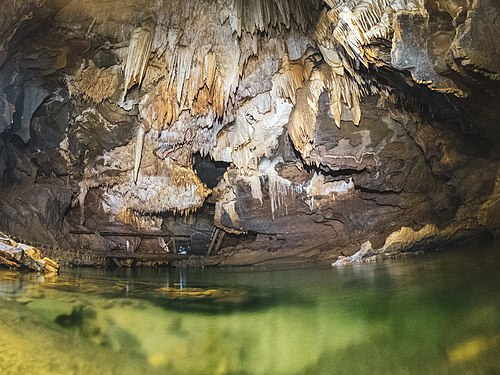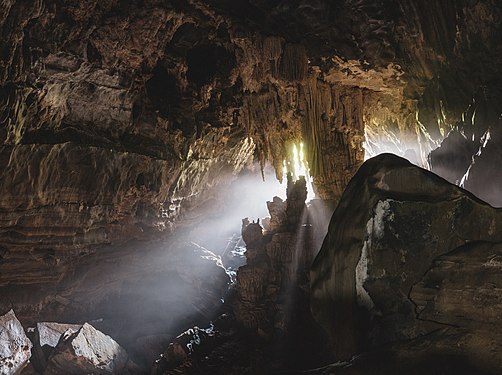Santana Nucleus is part of one of the most important Conservation Units in the world, the Alto Touristic State Park – PETAR. PETAR is located in Vale do Ribeira in Iporanga, in the southern region of the state of São Paulo.
To arrive
Car
- Leaving Iporanga:
- To get to Núcleo Santana, take SP 165, it is a dirt road that connects Iporanga to Apiaí, head towards Apiaí for 16 km (~30min), there will be a fork where the entrance to the Park is visible.
- Leaving Apiaí:
- Take the same SP 165, but now towards Iporanga, walk 25 km (~45 min), the entrance by this path is not so obvious, pay attention to the signs.
Buses
- Leaving Apiaí:
- Take the bus towards Iporanga, be careful, the buses only have two times, at 11 am and at 4 pm, they are not good for taking a walk in Núcleo Santana. If you only have the option of going by bus, it's better to stay in Iporanga.
- Leaving Iporanga:
- Take the bus towards Apiaí, get off in the Serro neighborhood. The bus leaves at 7 hrs and the journey takes almost 1 hr.
Look

24°31′41″S 48°42′48″W
Santana Nucleus MapThe Santana nucleus has the most popular caves in the park: Santana Cave, Morro Preto Cave, Couto Cave, Dirty Water Cave and Cafezal Cave.
- Santana cave - 1 . it is the second largest cave in the state of São Paulo and is considered one of the most beautiful in Brazil, due to the diversity of geological formations. Easily accessible, it is a 100 m walk from the visitors' kiosk through the cobbled path. The cave was adapted to receive ecotourists using structures that help and guide tourists along the way. Examples are the expansion of its original enlarged entrance, the addition of walkways made of the same rock as the cave and wooden stairs inside. The Santana cave has several upper levels, but only the lower conduit is active, sheltering the Roncador river. In its halls it is possible to see a variety of speleothems, largely represented in the main visitation circuit, including stalactites, stalagmites, curtains, travertine dams and helicites, some with picturesque shapes ("horse", "elephant's foot", " wedding cake”, “heart”, “turkey”, among others).
- Morro Preto Cave - 2 . : ideal for beginner ecotourists, this cave is considered an easy level. Access to the cave from the visitors' kiosk is 400 meters away, followed by a well-defined trail that begins after crossing a bridge over the Betari river. The main entrance is made after a path with steps, with high declivity (approximately 250 steps). It is 832 m long and 61 m uneven. Its visitation route is 200 m, with an average duration of 30 min. The entrance portico is one of the most beautiful in the Santana nucleus, measuring approximately 15 m high and 10 m wide, especially when viewed from the inside out, in addition to the conglomerate deposits that are cemented on its roof. Studies indicate that the cave was inhabited by primitive peoples (fluvial sambaquis) for thousands of years, as its remains were found in the late nineteenth century by researcher Ricardo Krone.
- Couto Cave - 3 . Located in the Santana nucleus, it is an easily accessible cave. It is located 300 m away from the visitors' kiosk, a path that is covered on foot by the trail that crosses the bridge over the Betari river. During the ascent you can hear the Couto Waterfall, approximately 5 m high, popular with tourists during hot days for having a beautiful fall and a well of cold water at its base. The cave is 471 m long and 26 m uneven, straight and not very bumpy. The visiting circuit is about 400 m long and is equipped with signage, handrail and wooden stairs. Among its attractions, we can mention: the entrance portico and the fauna commonly seen at the main entrance, such as harvestmen.
- Betari Trail: Extending 3.6 km, this path connects the visitors' kiosk to the Água Suja and Cafezal caves, in addition to the Andorinhas and Betarizinho cache, in that order. As a medium level trail, it presents challenges such as steps, stairs, walkways and crossing the Betari river with the aid of a safety rope.
- dirty water cave - 4 . Known for having turbid waters in rainy seasons, it is necessary to travel 1.3 km of the Betari Trail to reach this cave. The cave is 2985 m long and 220 m in height. With a closed visitation circuit (entry and exit through the same place), it is possible to walk around 1 km of cave, following the riverbed. Among its main attractions are: a walk along the Água Suja stream bed; underground waterfall; well with more than 100 m of unevenness, known as “External Debt”.
- cave of coffee plantation - 5 . One of the few dry caves open to visitors, it also has a medium degree of difficulty to be reached, as it is necessary to walk 1.8 km of the Betari trail to visit it. From the entrance, it is possible to see that this cave has different attractions, such as calcified shells, large, relatively flat rooms and beautiful geological formations, such as the room with aragonite flowers.
- Couto Waterfall - 6 .
- Betarizinho Waterfall - 7 .
- Waterfall of Swallows - 8 .
- attractions

Santana cave

Morro Preto Cave
.jpg/563px-Caverna_do_Couto_por_Rodrigo_Tetsuo_Argenton_(19).jpg)
Couto Cave

Couto Waterfall

dirty water cave

River Batari
.jpg/563px-Trilha_do_Betari_por_Rodrigo_Tetsuo_Argenton_(21).jpg)
Betari's Trail
Knife
- Hiking - PETAR has several trails open to the public. It is through them that you can access the main attractions of the park, such as waterfalls and caves. The most famous of them is the Betari River, in Núcleo Santana, a route of 3.6 km of medium difficulty that passes through two caves (Água Suja and Cafezal), in addition to waterfalls (Andorinhas and Betarizinho).
- Buoy-Cross - Aquatic activity carried out by buoys to the River Betari. Each buoy holds one person and the 2 km journey is done in a group. The activity can be performed in two sections with different levels of difficulty. For your practice it is necessary to use some safety items, such as a life jacket and helmet.
eat and drink
Park
There is no type of commerce within the park, but access with food is allowed at the site - some trails even have a picnic area. Outside the park, meals can be taken at inns, hotels and restaurants.
Iporanga
- Mangarito Bar and Restaurant: It has the best drinks and a special atmosphere. Pancakes, salads and desserts whet everyone's palate. In addition to the bar, there is a dance floor for those who like to enjoy forró or good rock music. António Honório da Silva Road, km 13. Bairro da Serra, Iporanga – SP. www.mangarito.com / [email protected]
- Abílio Restaurant: Serves delicious homemade food. It has been a great option for those who arrive unprepared. Attendant practically every day of the week. Offers lunch and dinner. It is close to the center of Bairro da Serra. Telephone: 15 3556 1405
- Pousada da Diva Restaurant: It has the most praised homemade food in the region. Stroganoff is the most famous dish and there is a lot of choice of salads. If you are not staying at the inn, advance booking is required. It is located in the Pousada da Diva, in Bairro da Serra. www.pousadadiva.com.br / [email protected] Telephone: 15 3556 1224
sleep
Accommodation in Iporanga

Pousada Nucleo Terra
- Pousada Núcleo Terra & Capitão Cave. Address: Rua João Evilásio Nunes, 160 - Alto Coqueiro, Iporanga - SP, 18330-000. Telephone: (15) 3556-1125. nucleoterra.com.br
- It has a tourism agency with specialized guides
- Diva's Inn. Address: Antônio Honório da Silva Road, km 13 - s/n - Serra, Iporanga - SP, 18330-000. Telephone: (15) 3556-1224. pousadadiva.com.br
- It has a tourism agency with specialized guides
- Glamping Mangarito. Road SP 165, Km 13, S/N - Bairro da Serra Petar, Iporanga - SP, 18330-000. Telephone: (15) 99745-8656. mangarito.com
Safety
- It is essential to have a guide to enter the park.
- Bring sneakers, regular shirt and pants (mandatory items) preferably fabrics that dry quickly (example: tactel), swimwear (bikini, swim trunks etc), sunscreen, insect repellent, canteen, non-slip sneakers, socks, towel, cape of rain and small backpack.
- Have extra batteries for flashlights and plastic bags to waterproof equipment, as well as to bring your trash back.
- Be careful on dirt roads in times of heavy rain, which can cause barrier falls and landslides.
Respect (rules)
- 01 local environmental monitor for every 08 people
- 20 or 30 minute intervals between each group to enter the caves
- Every visitor must have a flashlight powered by an electric battery
- The use of carburetors (visitors and local monitors) is prohibited
- The visitor must be wearing proper footwear, pants and a shirt with a normal sleeve that protects the shoulders
- Everyone must fill in a form at the Nucleus entrance or at the Guides' Kiosk with personal data and the control of each cave




.jpg/563px-Caverna_do_Couto_por_Rodrigo_Tetsuo_Argenton_(19).jpg)



.jpg/563px-Trilha_do_Betari_por_Rodrigo_Tetsuo_Argenton_(21).jpg)